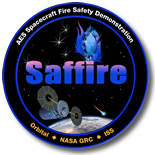Saffire
Spacecraft Fire Safety Demonstration (Saffire)
 Creating a safe environment for astronauts is the number one priority for all crew missions. Aboard the space station, astronauts have been able to conduct small-scale fire experiments, most recently during the BASS-M experiment.
Creating a safe environment for astronauts is the number one priority for all crew missions. Aboard the space station, astronauts have been able to conduct small-scale fire experiments, most recently during the BASS-M experiment.
The series of three Spacecraft Fire Safety Experiments (Saffire)was established to investigate large-scale flame growth and material flammability limits in space. The experiments are ignited in a Cygnus cargo vehicle after it has completed its primary International Space Station supply mission, departed the station, and before its planned destructive reentry to Earth.
Spacecraft Fire Safety
Understanding how fire behaves in microgravity, and how different materials propagate flames in space is immensely important for the development of future crew spacecraft. It also will help inform operational protocols for dealing with fire emergencies, particularly when astronauts do not have the ability to exit a spacecraft or quickly return to Earth.
Saffire is managed by NASA’s Advanced Exploration Systems Division, which pioneers innovative approaches and public-private partnerships to rapidly develop prototype systems, advance key capabilities, and validate operational concepts for future human missions beyond Earth orbit.
Saffire-I
Mission Completed July 2016
The Saffire-I experiment enclosure was approximately half a meter wide by 1 meter deep by 1.3 meter long and consisted of a flow duct and avionics bay. Inside the flow duct, the cotton-fiberglass blend burn sample measured 0.4 m wide by 1 meter long. When commanded by Orbital ATK and Saffire ground controllers operating from Dulles, Virginia, it was ignited by a hot wire. Previous to this experiment, the largest fire experiment that had been conducted in space is about the size of an index card.
Saffire-II
Mission completed Nov. 27, 2016
Saffire-II launched inside Orbital ATK’s Cygnus spacecraft during its sixth contracted cargo resupply mission with NASA to the International Space Station in October 2016. This second experiment in the Spacecraft Fire Safety series builds on the data captured during Saffire-I and expands the test portfolio with new materials. The nine samples in the experiment kit include a cotton-fiberglass blend, Nomex, and the same acrylic glass that is used for spacecraft windows. After Cygnus departs the station, and before its destructive reentry to Earth, mission controllers on the ground will remotely ignite the samples.
Saffire-III
Launched April 18, 2017 aboard Orbital ATK’s seventh contracted commercial resupply services mission for NASA.
The third in the Saffire series, Saffire-III will test the same cotton-fiberglass blend that was burned in Saffire-I, but at a higher flow velocity. Saffire-III will be ignited after the Cygnus module departs the space station in early June, before its destructive entry through Earth’s atmosphere.
Saffire-IV
Launched February 15, 2020 aboard Northrop Grumman CRS-15 to the International Space Station
Saffire-IV was ignited May 11, 2020, when Cygnus departed the International Space Station, before its destructive re-entry through Earth’s atmosphere. This large-scale fire experiment was remotely activated by Northrop Grumman operators and NASA/GRC Saffire staff helped monitor the experiment as it burned in four installments. Data returns will continue through May 28. Saffire IV burned the same materials were burned in Saffire II, but at different pressures and oxygen saturation for comparison.
NASA’s Spacecraft Fire Safety Demonstration Project, Saffire IV
NASA ignited another set of space fire experiments last week when Saffire IV lit a number of longer, stronger flames inside Northrop Grumman’s Cygnus cargo spacecraft.
Saffire, NASA’s Spacecraft Fire Safety Demonstration Project, is a series of six experiments that investigate how fires grow and spread in space, especially aboard future spacecraft bound for the Moon and Mars.
During the Saffire IV experiment, researchers burned a sample of SIBAL cloth, a composite of 75% cotton and 25% fiberglass. As the flame spreads shortly after ignition, you can see bright speckles behind, which are glowing char on the cloth.
Saffire-V
Ensuring the reliability of fire safety measures for future spacecraft requires experiments that provide a realistic examination of the risks, but it is difficult to study fires of practical size in an occupied spacecraft.The Spacecraft Fire Experiment-V (Saffire-V) investigation builds on the previous Saffire experiment using the Northrop Grumman Cygnus cargo resupply vehicle after it leaves the International Space Station (ISS). Saffire-V examines fire growth in the range of pressures and oxygen concentrations expected in future exploration spacecraft.
Saffire-VI
Understanding how fires spread in space is vital for developing fire prevention measures and fire suppression protocols, but it is difficult to perform flame-related experiments aboard a spacecraft. The Spacecraft Fire Experiments (Saffire) use the Cygnus resupply vehicle after it leaves the space station to reduce risk to crew and spacecraft. Saffire-VI, the last of the series, builds on previous results from Saffire-I through V to test flammability at different oxygen levels and to demonstrate fire detection, combustion product monitoring, and post-fire cleanup capabilities.
